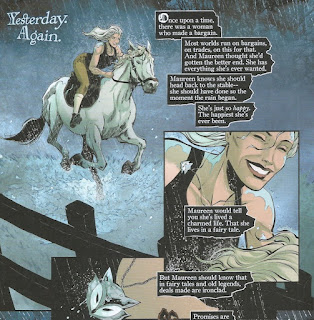Pick of the Brown Bag
August 15, 2023
by
Ray Tate
Welcome to the Pick of the Brown Bag, I'm Ray Tate and sometimes, when I can carve enough time out of my busy, busy schedule, I read and review comic books. If you don't see your comic book as a subject here, it may mean several things: it's mediocre and I didn't think it warranted review--cruel; I haven't gotten to it yet--okay; I haven't typed the review yet--lazy, or the ever popular I never heard of it--embarrassing.
Having time off from work, I read a slew of comic books. A hell of a lot of them met the cruel criteria. They were filled with boring art, boring stories and/or boring characters. Hawkgirl ain't one of them.
Writer Jadzia Axelrod creates an engaging, unusual narrative that's split between multiple characters.
Short stories normally rely on a single point of view. The detective doggedly homing in on the killer, for example. In a novella, novel, or even a long short story, you can parcel. In other words, one chapter, or break, is seen through the eyes of character A. The second chapter through B.
This kind of thing can be ham-fisted. The reader can become confused by constant vacillation. I've tossed books that do this. Too many characters. Too many points of view. Another one for the "dumpster."
Axelrod however is writing a comic book, and she very skillfully exploits its unique nature as a medium to flawlessly blend multi-person narratives.
Comic books unlike film do not require segues or visual trickery to convey meaning. The writing/art presents a perfect amalgam for the eye.
The comic book is a slow, subjective, immersive medium. You sit down and decide the reading pace of a comic book. Whereas in film, the filmmaker subjects a pace for the viewer, who is nevertheless seated.
Optical trickery such as segues, blends, fade outs and tinting signify the time and space should it be required. Not so in a comic book.
Axelrod begins the story with the introduction of new characters.
Who are these cast members? I must admit, my brain started cataloging Hawkman and Hawkgirl associates, for various periods and found nothing of use. Nevertheless, by the time you're finished reading Hawkgirl, you'll know why the ladies are in the book, what are their goals and this scene's very clever importance.
Using the device of the necklace, the writer shifts time on the third page.
On that page she kicks off the story proper with the infusion of the alien. Not Hawkgirl, who appears with the Justice League on page four, but something else.
Axelrod lets the dialogue, the interaction between old teammates and the beautiful action-filled artwork of Aman Nahuelpan and Adriano Lucas to draw the reader into this new chapter for Hawkgirl. It's an easy enticement.
For these colorful scenes, narration is unnecessary. Everybody can spot Superman by sight, but not everybody knows Power Girl and the Black Canary. Axelrod smoothly identifies each character in the dialogue. She makes that introduction part of the story.
Within the conversation, Axelrod reveals the ins and outs of Hawkgirl: her history, published and otherwise, her relationships, her abilities and more important for this story, her vulnerabilities.
It turns out that Hawkgirl may be putting on a brave front. All those lives, the voices in her head may be taking a toll. In addition because Hawkgirl's life is one of reincarnation, she may be prone to self-destruction, as indicated in another scene. On the other hand, it's possible outside forces influence her actions. Whatever the case, Hawkgirl does not die and reincarnate for her debut.
Axelrod surprises with a new hero.
Galaxy isn't actually new. Axelrod introduced her in a graphic novel gauged for younger readers. However, she knows you may have missed it. So the narration returns.
Mary Sue alert? No. Not really. Hawkgirl is the star of the book, and she gets the focus. Galaxy's presence is merely sauce for the goose. Perhaps, Axelrod wanted to give Hawkgirl a protege, or merely a friend outside the Justice League. A feat she duplicates in a different way when Kendra meets up with a college chum.
It's nice that Axelrod isn't just dealing with Hawkgirl nor her many incarnations. In fact with regard to the latter, none show up. Not even in flashback. She's more interested in looking at Kendra as a person. With that in mind, Abeline isn't just window dressing for Kendra. Axelrod briefly but succinctly builds on Abeline's characterization and history.
Normally, I would object to smashing real world politics and limitations into a comic book, but Nazis exist in the DCU just as unfortunately they still exist in our twenty-first century reality. So, Black Lives Matter and protesting bigotry is fair game in a comic book even when in the presence of men and women who routinely defy gravity.
If Axelrod hasn't sold you on Hawkgirl yet, she's got one more all-in move.
That's right. Batman. And hell, didn't Nahuelpan and Lucas pull out all the stops for the depiction? When you're given the opportunity to professionally illustrate Batman, you don't turn in shoddy work.
Batman and Hawkgirl served in the Justice League before the Crisis on Infinite Earths, before the whole reincarnation thing smooshed all the hawks together. More importantly, Bruce Timm's animated Justice League suggested a substantial relationship between Batman and Hawkgirl. Right from the get-go in the pilot, Batman suggests that he knows Hawkgirl from a previous encounter. Perhaps even encounters. As the series progresses, their banter indicate a growing friendship. So, Axelrod reinforcing that camaraderie as well as restoring the detective colleagues aspect pretty much puts Hawkgirl over the top.
As to whether or not you should buy now or wait for the trade. I advise buying now. The paper quality in the comic book is excellent for bringing out the best in the art. If DC publishes this on shiny paper, you might lose something in the transfer.







